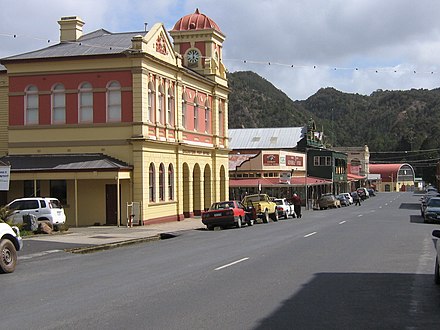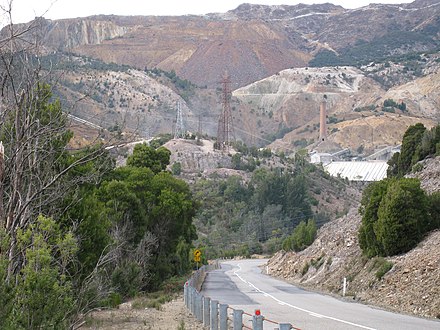Queenstown (Tasmania) - town in Western Tasmania, Australia
Queenstown is an old mining town in Western Tasmania, that has been recognised by the National Trust as a historic town. It is about a 4 hour drive from Hobart on the Lyell Highway.

Understand
Mining began here in the late 1800s, first with gold and later copper. It remains an important industry and the main employer. In 2005-06, Copper Mines of Tasmania produced 2.6 million tonnes of copper concentrate. Tourism is a growing industry,
Queenstown is the base of the West Coast Wilderness Railway (an Abt - rack railway), which runs to Strahan and draws large numbers of tourists. The original railway, used to transport ore from the mines to the port at Regatta Point/Strahan, closed and was removed in the 1960s. It was restored and reopened in the early '90s. Services were suspended in winter 2013 for repairs, but they recommenced after completion.
Queenstown is an interesting town, nestled in the Queen River valley. Summers can be hot and can reach 30+ degrees, although it is not uncommon to have snow on Mt Owen in December. Winters are cool and wet, with snow falling regularly on the peaks on the West Coast Range that can be seen from the town. It is not uncommon for the roads into Queenstown to be blocked, and for the town cut off for short periods during the middle of winter. The best time to visit is between December and April.
Many of the early buildings remain and a stroll around town is a must if you want a sense of what the town was like during the height of the copper mining operations.
The drive in to Queenstown over Gormanston Hill is a startling introduction to the town. The barren landscape was brought about by the combination of tree removal for the smelters, and the subsequent years of pollution. Trees were logged to fuel the furnaces of the smelters in the early years. Then large amounts of sulphur from the smelting process polluted the soils, killing much of the ground vegetation. Heavy rainfall of the area washed away most of the topsoil. The combination of the effects of tree removal, heavy rains, smelter fumes and uncontrolled bushfires, are evident in the bare ground areas that are spread across the foothills of Mount Lyell and Mount Owen to this day.
Queenstown is a great stopover when visiting the West Coast, with many West Coast attractions only a short drive away. Queenstown has a good range of places to stay, as well as very picturesque drives to the nearby attractions.
Strahan is just over 40km, Zeehan about 30 km, Cradle Mountain and Lake St Clair just under 100 km. The Franklin-Gordon Wild Rivers National Park is also nearby. The trout fishing at man-made Lake Burbury is world class.
Get in
By bus
Buses from Hobart run twice weekly, on Tuesdays and Fridays. Buses from Burnie run to Queenstown daily. Check timetables for the latest information.
By car
; From the east The drive from Hobart takes 3.5 to 4 hours (depending upon conditions), taking you through towns such as New Norfolk, Hamilton, Ouse and Derwent Bridge before winding its way through the Franklin-Gordon Wild Rivers National Park, part of the Tasmanian Wilderness World Heritage Area.
Leaving the park, and driving around the eastern foot of Mount Owen, and up Linda valley with Mount Lyell to the north and Mount Owen to the south, you come to the ghost towns of Linda and Gormanston, both of which were large communities during the early mining booms. Of particular interest are the ruins of the Royal Hotel at Linda.
Once past Gormanston the road becomes a narrow and winding affair, where all caution should be taken, but this is also where the spectacular views of the surrounding barren hills of Queenstown begin.
Once over Gormanston hill there is a lookout on your left which takes in views of Queenstown and the Queen River Valley. It is well worth a stop for photos, be careful of the wind. In wet and rainy weather look behind you to see the Horsetail Falls that come down the north western slopes of Mount Owen.
Once out of the Linda Valley, and past the lookout you drive down the winding road with on the right hand side, the tree stumps in the clay from one hundred years ago, and down past the black slag heap and into Queenstown.
; From the north From Burnie it is a 2.5hr drive along the A10, which takes you through the village of Tullah, where you first get to see Mt Murchison as it looms up ahead of you. Past Tullah you have a choice of routes. The A10 takes you on to Rosebery and over Mt Black or you can take the B28 around Lake Plimsoll, where there are spectacular views of Cradle Mountain National Park and the Franklin River World Heritage area. Both drives are on excellent road surfaces, although a little windy in places. The Lake Plimsoll road is about 15km shorter than the A10 into Queenstown.
The two routes above are only a guide (as well as the time it might take) and that a number of others can be taken from Launceston.
; Hazards Regardless of which route you take, and depending on what time of year that you travel, weather and road conditions should be taken into account.
Also if you are driving the roads for the first time, it is well worth avoiding night driving in winter. Also first time drivers must be aware of the narrowness of the road, and sections of very sharp and sudden bends where speed can be a serious problem. Consider that around the next corner rock fall or black ice hazards that suddenly confront the unexpecting driver.
The roads around Queenstown can be covered in ice and snow during winter and right up to early December.
Wildlife also frequent all roads into and out of Queenstown. Please drive carefully and obey speed limits and caution signs.
By bicycle
The more adventurous do travel by bike, and the previous car information is valuable to take note of. The hills are steep in places, whether coming from the east coast or the north coast. There is very little room to negotiate with vehicles in parts, and caution is advised the same as for cars above.
If you are fit, and adequately equipped, bicycle trips through the mountains before and after Queenstown are exhilarating and well worth the effort in good weather.
By train
The West Coast Wilderness Railway (dead link: January 2023) operates as a tourist attraction between Queenstown and Strahan, a distance of 34 km. There are a range of journey options - from Strahan and Queenstown.
The original ordinary railway connection between Queenstown and the rest of Tasmania closed in 1960.
Most journeys on the railway utilise Queenstown as the base to travel from. There is also a service from Strahan as the base.
By plane
Strahan Airport - Although helicopter and fixed-wing flights operate from here for charter flights into the south-west wilderness area, or over locations in western Tasmania, there are no scheduled passenger services to Strahan from other airports in Tasmania. Queenstown also has an airstrip, which was used in the past as a regular stopping place, but now is only used sometimes in emergencies.
Get around

See
- Evans Old Corner Store & Market. restored 19th-century building, with monthly markets.
- Spion Kopf Lookout. An excellent location for views over the town, to the south, and the rare rock based football oval to the north.
- The Galley Museum, +61 3 6471-1483. Multiple displays and a lot of information on the history of Queenstown and district, with intriguing photographic displays. Also included are minerals collections and displays of artefacts from the days of the town as a major town of the area. Housed in the original Imperial Hotel, which was built in 1897.
- Iron Blow Lookout. 2021-06-14
Do
- Bradshaw's Sawmill, +61 3 6471-1688. Lynchford Road. Visit a working sawmill. Exotic Huon pine, blackwood and sassafras timber.
- Donaghy's Hill, located on the Lyell Highway about 40 min east from Queenstown, on the road back to Hobart. Easy walk to the top on a well-maintained track. Beautiful views of the Franklin River Valley.
- Douggie's Mine Tours, +61-3-6471-1472. Corner of Driffield St and Orr St. Visit a working underground copper mine. Travel 7 km down the 'Main Decline' in a 4WD station wagon. One of only two such tours worldwide.
- Lake Burbury, trout fishing is possible. The lake is next to the Lyell Highway east of Gormanston, the other side of the West Coast Range.
- Nelson River Falls, located near the Lyell Highway about 20 minutes east of Queenstown. A nice walking track through a rainforest.
- Roamwild Tours, The Paragon Theatre, 11 McNamara Street Queenstown TAS 7467, +61 407 049 612 (mobile), info@roamwild.com.au. Roamwild Tours offer some fantastic short trips from Queenstown for small groups. The Lost Mines and Ancient Pines tour is an incredible journey into the World Heritage Wilderness Area, including a visit into an old mine, and an amazing look at the sites of one of Australia's big conservation battles. 2017-10-08
Buy
Local souvenirs include Huon Pine and Copper mementos, as well as books and postcards of the old copper mine workings, and railway. These can be purchased from several stores along Orr Street, or the railway station gift shop.
Eat
Most of hotels serve food, but there are some cafes and restaurants along Orr Street.
- Broken Halo Coffee Kitchen, 7 Orr St. Cafe with sandwiches, fish and chips, and cakes. Seating available inside and out.
- Rusty Iron, 39 Orr St. +61 3 6444 5022. Thai and Chinese cuisine. Includes vegetarian and vegan options. Open for lunch and dinner.
- Moonscape Wine Bar and Cafe, 42 Orr St. Cafe and wine bar with limited but good food menu. Some vegan options. There is a beer lounge at the back.
- Trax Cafe, 1 Driffield St. +61 3 6471 0115. Located inside the train station and open from morning until evening. The menu includes breakfast, lunch, dinner, and snacks. There are vegan options and alcohol is also served.
Drink
- Empire Hotel, 2 Orr St, +61 3 6471-1699. Heritage building with National Trust-listed staircase. Dining room with open fireplace. Lounge bar, public bar and bottle shop. Gaming machines. Accommodation.
Sleep
- Chancellor Inn, +61 3 6471-1033. Batchelor Street. 60 units. Licensed restaurant for breakfast and dinner; 3.5 stars.
- Copper Country Cabins, 13 Austin Street, +61 417 398 343. Self-contained cabins just outside town.
- George's Cottage, 3 Peter Street, +61 419 565 155. Self-contained cottage.
- Gold Rush Motor Inn, 65 Batchelor Street, +61-3-6471-1005. 26 motel units with licensed restaurant and bar.
- Pioneers Retreat, 1 Batchelor Street, +61-3-6471-3033. Self-contained units.
- Queenstown Cabin and Tourist Park, 17 Grafton Street, +61-3-6471-1332. Two-, four- and six-berth self-contained cabins. Caravan sites. Backpackers' and fishermen's rooms. Grassed tenting area. Communal kitchen and modern amenities block, plus laundromat.
- Queenstown Motor Lodge, 54-58 Orr Street, +61-3-6471-1866. 24 motel units, plus dining facilities and lounge bar. Close to shops.
- Silver Hills Motel, +61-3-6471-1755. Penghana Road. 54 motel units.